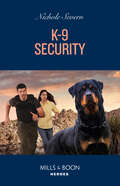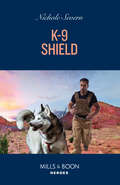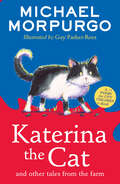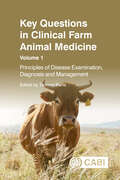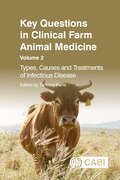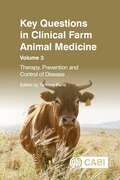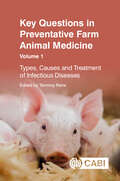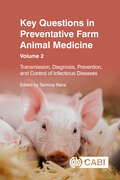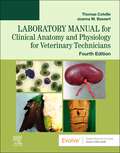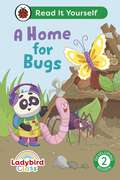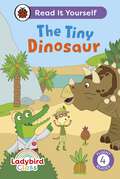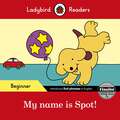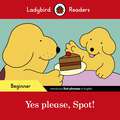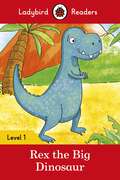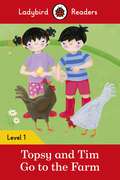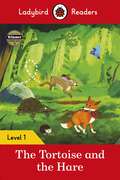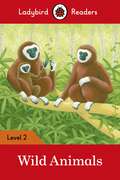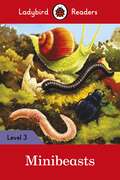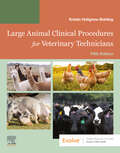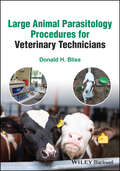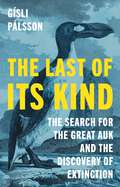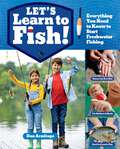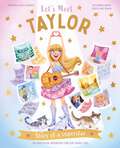- Table View
- List View
K-9 Security (New Mexico Guard Dogs #1)
by Nichole SevernThis case will test even the toughest heart…
Katerina the Cat and Other Tales from the Farm (A Farms for City Children Book)
by Michael MorpurgoA charming story collection from Michael Morpurgo and illustrated by Guy Parker-Rees – full of friendship and adventure, and perfect to read together
Key Questions in Clinical Farm Animal Medicine, Volume 1: Principles of Disease Examination, Diagnosis and Management (Key Questions)
by Kanchan Arya Sonam Bhatt Ranbir Singh Jatav Praveen Kumar Anil Kumar Vaishali Kumre Vipin Maurya Shashi Pradhan K. S. Prasanna Aditya Pratap Sunil Punia Neha Rao Mitali Singh S. Sivaraman L. Sowmiya D. Sumathi S. Yogespriya Jigyasa RanaProviding well over 1,500 questions to test your knowledge of clinical farm animal medicine, the book has been produced in a convenient format so that it can be used at any time in any place. Each chapter starts with a brief introduction to the topic before providing relevant multiple-choice questions. Covering clinical veterinary medicine for common livestock species, this book includes questions about: - clinical examination; - electrolyte balance and fluid therapy; - diseases by body system, including respiratory, endocrine, cardiovascular, nervous, digestive and musculoskeletal. Including a full chapter introducing general concepts of clinical disease, this self-test resource for students provides a convenient and useful current source of information to anyone interested in learning, revising and assessing their knowledge.
Key Questions in Clinical Farm Animal Medicine, Volume 2: Types, Causes and Treatments of Infectious Disease (Key Questions)
by A Ashwini B. K. Bhagya Sabita Behera Dipanwita Bhattacharya Banothu Dasmabai Nourhan Eissa Lesley Farms G.K. Chetan Kumar Lunavat Gopala Ola H. Harb Abbas Rabiu Ishaq Dayanidhi Jena Anil Kumar Ankesh Kumar Praveen Kumar Archana Mahapatra Ram Niwas Sunil Punia R. Nethra Pratistha ShrivastavaProviding well over 1,500 questions to test your knowledge of clinical farm animal medicine, the book has been produced in a convenient format so that it can be used at any time in any place. Each chapter starts with a brief introduction to the topic before providing relevant multiple-choice questions. Covering clinical veterinary medicine for common livestock species, this book includes questions about: - diseases of the reproductive, integumentary and urinary systems; - anaesthesia and pain management; - perinatal and geriatric diseases. With full chapters also covering diseases of the eye and ear, this self-test resource for students provides a convenient and useful current source of information to anyone interested in learning, revising and assessing their knowledge.
Key Questions in Clinical Farm Animal Medicine, Volume 3: Therapy, Prevention and Control of Disease (Key Questions)
by Manoj Kumar Ahirwar D Sai Bhavani P Rama Devi G. S. Harita Babu Lal Jangir K. Sindhu Deepika Lather Alok Mishra Vikas Nehra P. Ramesh Abhishek Pathak G. S. Haritha R. S. Sethi Dr Nasrul Shaikh Brejesh Singh Amita Tiwari Shivangi UdainiyaProviding well over 1,500 questions to test your knowledge of clinical farm animal medicine, the book has been produced in a convenient format so that it can be used at any time in any place. Each chapter starts with a brief introduction to the topic before providing relevant multiple-choice questions. Covering clinical veterinary medicine for common livestock species, this book includes questions about: - diseases of the haemolymphatic and immune system; - metabolic, genetic, neonatal and deficiency diseases; - poisoning. Including a full chapter covering emergency and critical care, this self-test resource for students provides a convenient and useful current source of information to anyone interested in learning, revising and assessing their knowledge.
Key Questions in Preventative Farm Animal Medicine, Volume 1: Types, Causes and Treatment of Infectious Diseases (Key Questions)
by Chetan D. Chavda Bhupamani Das Aishwarya Dash H. Dhanalakshmi Abrar Ul Haq Biswa Ranjan Jena J. Jyothi Jaysukh B. Kathiriya M. Bhavya Sree Sivajothi SrigireddyProviding well over 1,000 questions to test your knowledge of preventative farm animal medicine, the book has been produced in a convenient format so that it can be used at any time in any place. Each chapter starts with a brief introduction to the topic before providing relevant multiple-choice questions. Covering preventative veterinary medicine for common livestock species, the book includes questions on: - general concepts of preventative medicine; - viral, bacterial, fungal and mycoplasma diseases; - ecto- and endo-parasitic infections. This self-test resource for students provides a convenient and useful current source of information to anyone interested in learning, revising and assessing their knowledge.
Key Questions in Preventative Farm Animal Medicine, Volume 2: Transmission, Diagnosis, Prevention, and Control of Infectious Diseases (Key Questions)
by Sonam Bhatt Snehil Gupta Surbhi Gupta Sushma Gupta K. Jayalakshmi K. Karthika Anil Kumar Simant Kumar Nanda Arpita Padhy Abhishek Pathak Jigar Raval Amit Ranjan Sahu Rajesh Kumar Sahu Barkha Sharma Jitendra TiwariProviding well over 1,000 questions to test your knowledge of preventative farm animal medicine, the book has been produced in a convenient format so that it can be used at any time in any place. Each chapter starts with a brief introduction to the topic before providing relevant multiple-choice questions. Covering preventative veterinary medicine for common livestock species, the book includes questions about: - rickettsial and protozoan diseases; - prophylaxis in animals; - diagnostic techniques; - collection, preservation, processing and dispatch of clinical materials. Including a full chapter considering important transboundary, emerging and exotic diseases, this self-test resource for students provides a convenient and useful current source of information to anyone interested in learning, revising and assessing their knowledge.
Laboratory Manual for Clinical Anatomy and Physiology for Veterinary Technicians - E-Book
by Thomas P. Colville Joanna M. BassertLearn to apply your A&P learning in the lab setting with the Laboratory Manual for Clinical Anatomy and Physiology for Veterinary Technicians, 4th Edition. This practical laboratory resource features a variety of activities, such as terminology exercises, illustration identification and labelling, case presentations, and more to help reinforce your understanding of veterinary anatomy and physiology. The laboratory manual also features vivid illustrations, lists of terms and structures to be identified, and step-by-step dissection guides to walk you through the dissection process. Clinically oriented learning exercises introduce you to the language of anatomy and physiology as you identify structures and learn concepts. Clear, step-by-step dissection instructions for complex organs such as the heart familiarize you with the dissection process in a very visual, easy-to-understand format. Learning objectives, the clinical significance of the content, and lists of terms and structures to be identified appear at the beginning of each chapter. Review activities and study exercises are included in every chapter to reinforce important information. High-quality, full-color illustrations provide a solid understanding of the details of anatomic structure.
Ladybird Class A Home for Bugs: Read It Yourself - Level 2 Developing Reader (Read It Yourself)
by LadybirdJoin Ladybird Class on another imaginative learning adventure! When Tao Meerkat, Noah Panda and friends are transported to a beautiful meadow to learn all about bugs, they find themselves on a rescue mission! Can they work together to build a new home for their minibeast friends?A Home for Bugs is from Developing Reader Level 2 and is ideal for readers aged from 5+ who can read short, simple sentences with help.Each book has been carefully checked by educational and subject consultants and includes comprehension puzzles, book band information, and tips for helping children with their reading.With five levels to take children from first phonics to fluent reading and a wide range of different stories and topics for every interest, Read It Yourself helps children build their confidence and begin reading for pleasure.
Ladybird Class The Tiny Dinosaur: Read It Yourself - Level 4 Fluent Reader (Read It Yourself)
by LadybirdJoin Ladybird Class on another imaginative learning adventure! The class find themselves in the Cretaceous Period and want to help their new friend Tiny. Will they be able to protect her from the carnivorous Tyrannosaurus rex? Ladybird Class: The Tiny Dinosaur is from Fluent Reader Level 4 and is ideal for more fluent readers aged from 7+ who are starting to read independently.Each book has been carefully checked by educational and subject consultants and includes comprehension puzzles, book band information, and tips for helping children with their reading.With five levels to take children from first phonics to fluent reading and a wide range of different stories and topics for every interest, Read It Yourself helps children build their confidence and begin reading for pleasure.
Ladybird Readers Beginner Level - Spot - My name is Spot! (Ladybird Readers)
by LadybirdAsk and answer "What is your name?" with Spot. Ladybird Readers is a graded reading series of traditional tales, popular characters, modern stories, and non-fiction, written for young learners of English as a foreign or second language.Beautifully illustrated and carefully written, the series combines the best of Ladybird content with the structured language progression that will help children develop their reading, writing, speaking, listening and critical thinking skills.The six levels of Readers and Activity Books follow the CEFR framework and include language activities that provide preparation for the Cambridge English: Young Learners (YLE) exams.My name is Spot!, a Beginner Reader, introduces children to their very first conversational phrases.
Ladybird Readers Beginner Level - Spot - Yes please, Spot! (Ladybird Readers)
by LadybirdSay "Yes, please!" with Spot. Ladybird Readers is a graded reading series of traditional tales, popular characters, modern stories, and non-fiction, written for young learners of English as a foreign or second language.Beautifully illustrated and carefully written, the series combines the best of Ladybird content with the structured language progression that will help children develop their reading, writing, speaking, listening and critical thinking skills.The six levels of Readers and Activity Books follow the CEFR framework and include language activities that provide preparation for the Cambridge English: Young Learners (YLE) exams. Yes please, Spot!, a Beginner Reader, introduces children to their very first conversational phrases.
Ladybird Readers Level 1 - Rex the Big Dinosaur (Ladybird Readers)
by LadybirdRex is a big dinosaur. He sees some small dinosaurs. They are playing. "Can I play, too?" asks Rex. Ladybird Readers is a graded reading series of traditional tales, popular characters, modern stories, and non-fiction, written for young learners of English as a foreign or second language. Beautifully illustrated and carefully written, the series combines the best of Ladybird content with the structured language progression that will help children develop their reading, writing, speaking, listening and critical thinking skills.The five levels of Readers and Activity Books follow the CEFR framework and include language activities that provide preparation for the Cambridge English: Young Learners (YLE) Starters, Movers and Flyers exams. Rex the Dinosaur, a Level 1 Reader, is Pre-A1 in the CEFR framework and supports YLE Starters exams. Short sentences contain a maximum of two clauses, using the present tense and some simple adjectives.
Ladybird Readers Level 1 - Topsy and Tim - Go to the Farm (Ladybird Readers)
by Jean Adamson LadybirdTopsy and Tim like going to the farm. They help the farmer, get some eggs, see the animals, and give a calf some milk.Ladybird Readers is a graded reading series of traditional tales, popular characters, modern stories, and non-fiction, written for young learners of English as a foreign or second language.Beautifully illustrated and carefully written, the series combines the best of Ladybird content with the structured language progression that will help children develop their reading, writing, speaking, listening and critical thinking skills.The eight levels of Readers and Activity Books follow the CEFR framework and include language activities that provide preparation for the Cambridge English: Young Learners (YLE) Starters, Movers and Flyers exams.Topsy and Tim Go to the Farm, a Level 1 Reader, is Pre-A1 in the CEFR framework and supports YLE Starters exams. Short sentences contain a maximum of two clauses, using the present tense and some simple adjectives.
Ladybird Readers Level 1 - The Tortoise and the Hare (Ladybird Readers)
by LadybirdLadybird Readers is an ELT graded reader series for children aged 3-11 learning English as a foreign or second language. The series includes traditional tales, popular characters, modern stories, and non-fiction.· Beautifully illustrated books, carefully written by language learning experts· Structured language progression to develop children's reading, writing, speaking, listening and critical thinking skills· Eight levels follow the Common European Framework of Reference for language learning (CEFR)· Language activities provide preparation for the Cambridge English Pre-A1 to A2 (YLE) tests· A unique code in each printed book provides access to online audio, extra activities and learning resourcesLadybird Readers Level 1: The Tortoise and the Hare, a Level 1 Reader, is Pre-A1 in the CEFR framework and includes practice for the Cambridge English Pre-A1 Starters tests. Short sentences contain a maximum of two clauses, using the present tense and some simple adjectives.Hare can run and jump. Tortoise can walk. Hare and Tortoise have a race, but can Tortoise win? Hare is fast and he is slow!Visit the Ladybird Education website for more information.
Ladybird Readers Level 2 - Wild Animals (Ladybird Readers)
by LadybirdLadybird Readers is an ELT graded reader series for children aged 3-11 learning English as a foreign or second language. The series includes traditional tales, popular characters, modern stories, and non-fiction.Beautifully illustrated and carefully written by language learning experts, the series combines the best of Ladybird content with the structured language progression that will help children develop their reading, writing, speaking, listening and critical thinking skills.The eight levels follow the Common European Framework of Reference for language learning (CEFR) and include language activities that provide preparation for the Cambridge English Pre-A1 to A2 (YLE) tests.Visit the Ladybird Readers website for more information. The unique code provided in each printed book will provide access to audio, extra activities and learning resources.Wild Animals, a Level 2 Reader, is A1 in the CEFR framework and includes practice for the Cambridge English A1 Movers tests. Short sentences contain a maximum of two clauses, introducing the past tense and some simple adverbs.Wild animals do not live with people. They live on the plains, in trees, in deserts and in the sea.
Ladybird Readers Level 3 - Minibeasts (Ladybird Readers)
by LadybirdFind out about many different minibeasts and where they live. What do spiders eat? How do bees help us? Why don't we like flies?Ladybird Readers is a graded reading series of traditional tales, popular characters, modern stories, and non-fiction, written for young learners of English as a foreign or second language.Beautifully illustrated and carefully written, the series combines the best of Ladybird content with the structured language progression that will help children develop their reading, writing, speaking, listening and critical thinking skills.The eight levels of Readers and Activity Books follow the CEFR framework and include language activities that provide preparation for the Cambridge English: Young Learners (YLE) exams. Minibeasts, a Level 3 Reader, is A1+ in the CEFR framework and supports YLE Movers exams. The longer text is made up of sentences with up to three clauses, some expression of future meaning, comparisons, contractions and relative clauses.
Large Animal Clinical Procedures for Veterinary Technicians - E-Book: Large Animal Clinical Procedures for Veterinary Technicians - E-Book
by Kristin J. Holtgrew-BohlingGet the big picture on the vet tech’s role and responsibilities in large animal care! A practical, comprehensive guide, Large Animal Clinical Procedures for Veterinary Technicians, 5th Edition describes how to set up, assist, and follow through on medical procedures and treatment regimens for domestic livestock. The book begins with an overview of livestock handling, reproduction, and nutrition, along with the skills required in hospital management. Following are separate sections on horses, cattle, sheep and goats, llamas and alpacas, swine, and poultry, with each section including chapters examining husbandry, clinical and surgical procedures, and common diseases. Written by expert clinician and vet tech educator Kristin Holtgrew-Bohling, this text provides an ideal study tool in preparing for the VTNE® and for everyday practice. Comprehensive large animal coverage is specifically tailored to the needs of veterinary technician students. Coverage of the essential large animal-related tasks in the CVTEA Manual of Accreditation for Veterinary Technology Programs prepares you to pass the Veterinary Technology National Exam (VTNE®). Step-by-step procedures explain how and why a clinical procedure is performed, and the roles that you fill in preparing for, assisting in, and following up the procedure. "How-to" chapters within each species section examine husbandry, clinical procedures, surgical procedures, and common diseases — so veterinary technicians, acting under instructions of veterinarians, can plan and follow through on procedures and treatment regimens for large animals. Evolve website includes quizzes, images, and reference materials to reinforce understanding. Full-color photographs and line drawings show step-by-step procedures in areas such as restraint, bandaging, physical examination techniques, and diagnostic procedures. Coverage of husbandry and breeds demonstrates how day-to-day housing and feeding affect the care of many large animal diseases, and also helps you provide quality client education. Livestock Industry section provides an overview of safety and handling, reproduction, and nutrition, so you can better understand the practices, procedures, and decisions in large animal veterinary medicine. Learning features enhance critical thinking and decision making with case studies, clinical applications, key terms, chapter outlines, learning objectives, and Technician Notes. NEW! Coverage of animal care includes care in small-scale and hobby farm settings, fear-free care, and IV catheter maintenance. NEW! Updated information includes illegal drugs, remote delivery devices, nutrition and environmental enrichment for each species, carcass removal information, breeding soundness exam information for bulls, poisonous plants and other toxins, needle disposal and broken needle guidelines, sedation protocols, dehydration tables for calves, and more. NEW! Updated images, case studies, step-by-step procedures, disease information, and terminology ensure that you have the most current information. NEW! Updated test questions and chapter quizzes on the Evolve website make it easier to study, review, and remember difficult subject matter.
Large Animal Parasitology Procedures for Veterinary Technicians
by Donald H. BlissLarge Animal Parasitology Procedures for Veterinary Technicians Comprehensive illustrated reference on parasitic nematodes, cestodes, coccidian oocysts and trematode egg recoveries, identification, and enumeration with treatment strategies for five separate categories of animal patients Large Animal Parasitology Procedures for Veterinary Technicians illustrates, in detail, the most sensitive diagnostic procedure for internal parasites of domestic animals using the Modified Wisconsin Sugar Flotation Method. With step-by-step pictures and bullet-point instructions, this text discusses sample collection and storage techniques, as well as the strengths and weaknesses inherent to other commonly used tests. Potential sources for infection, the seasonality of the infection, possible environmental recontamination, and control strategies are all covered in detail, with suggestions to prevent reoccurrences. Parasites of the equine, large and small ruminants (including alpaca), swine, poultry and hoofed wildlife patients are included, with full color images for quick identification, an assessment of life cycle stage, and discussion of zoonotic potential. Each species section is heavily illustrated with comparative images to aid the technician in quickly identifying the parasite and life cycle stage. In Large Animal Parasitology Procedures for Veterinary Technicians, readers can find information on: The definition and economic importance of parasitisms, details on the epidemiology of parasitic enteritis, including basics of protozoology, helminthology, and overall applied veterinary parasitology Sample collection and shipment of specimens, including collection, storage, examinations, and interpretations Fecal examination using the Modified Wisconsin Sugar Flotation method, compared with gross examination, smear, sedimentation, and other flotation techniques, plus a fluke egg recovery technique and the Baermann technique for lungworm larvae recovery Internal parasite diagnosis and worm egg recoveries, descriptions and pictures of nematode parasite eggs (as well as coccidia oocysts), plus tapeworm eggs and fluke egg descriptions and photos for a variety of host animals Illustrating commonly used diagnostic tests in veterinary parasitology, with step-by-step instructions for accuracy, Large Animal Parasitology Procedures for Veterinary Technicians is an essential reference for veterinary technicians and veterinary technician students dealing with domestic animals, including horses, ruminants, swine, poultry, and hoofed wildlife.
Large Animal Parasitology Procedures for Veterinary Technicians
by Donald H. BlissLarge Animal Parasitology Procedures for Veterinary Technicians Comprehensive illustrated reference on parasitic nematodes, cestodes, coccidian oocysts and trematode egg recoveries, identification, and enumeration with treatment strategies for five separate categories of animal patients Large Animal Parasitology Procedures for Veterinary Technicians illustrates, in detail, the most sensitive diagnostic procedure for internal parasites of domestic animals using the Modified Wisconsin Sugar Flotation Method. With step-by-step pictures and bullet-point instructions, this text discusses sample collection and storage techniques, as well as the strengths and weaknesses inherent to other commonly used tests. Potential sources for infection, the seasonality of the infection, possible environmental recontamination, and control strategies are all covered in detail, with suggestions to prevent reoccurrences. Parasites of the equine, large and small ruminants (including alpaca), swine, poultry and hoofed wildlife patients are included, with full color images for quick identification, an assessment of life cycle stage, and discussion of zoonotic potential. Each species section is heavily illustrated with comparative images to aid the technician in quickly identifying the parasite and life cycle stage. In Large Animal Parasitology Procedures for Veterinary Technicians, readers can find information on: The definition and economic importance of parasitisms, details on the epidemiology of parasitic enteritis, including basics of protozoology, helminthology, and overall applied veterinary parasitology Sample collection and shipment of specimens, including collection, storage, examinations, and interpretations Fecal examination using the Modified Wisconsin Sugar Flotation method, compared with gross examination, smear, sedimentation, and other flotation techniques, plus a fluke egg recovery technique and the Baermann technique for lungworm larvae recovery Internal parasite diagnosis and worm egg recoveries, descriptions and pictures of nematode parasite eggs (as well as coccidia oocysts), plus tapeworm eggs and fluke egg descriptions and photos for a variety of host animals Illustrating commonly used diagnostic tests in veterinary parasitology, with step-by-step instructions for accuracy, Large Animal Parasitology Procedures for Veterinary Technicians is an essential reference for veterinary technicians and veterinary technician students dealing with domestic animals, including horses, ruminants, swine, poultry, and hoofed wildlife.
The Last of Its Kind: The Search for the Great Auk and the Discovery of Extinction
by Gísli PálssonHow an iconic bird&’s final days exposed the reality of human-caused extinctionThe great auk is one of the most tragic and documented examples of extinction. A flightless bird that bred primarily on the remote islands of the North Atlantic, the last of its kind were killed in Iceland in 1844. Gísli Pálsson draws on firsthand accounts from the Icelanders who hunted the last great auks to bring to life a bygone age of Victorian scientific exploration while offering vital insights into the extinction of species.Pálsson vividly recounts how British ornithologists John Wolley and Alfred Newton set out for Iceland to collect specimens only to discover that the great auks were already gone. At the time, the Victorian world viewed extinction as an impossibility or trivialized it as a natural phenomenon. Pálsson chronicles how Wolley and Newton documented the fate of the last birds through interviews with the men who killed them, and how the naturalists&’ Icelandic journey opened their eyes to the disappearance of species as a subject of scientific concern—and as something that could be caused by humans.Blending a richly evocative narrative with rare, unpublished material as well as insights from ornithology, anthropology, and Pálsson&’s own North Atlantic travels, The Last of Its Kind reveals how the saga of the great auk opens a window onto the human causes of mass extinction.
The Last of Its Kind: The Search for the Great Auk and the Discovery of Extinction
by Gísli PálssonHow an iconic bird&’s final days exposed the reality of human-caused extinctionThe great auk is one of the most tragic and documented examples of extinction. A flightless bird that bred primarily on the remote islands of the North Atlantic, the last of its kind were killed in Iceland in 1844. Gísli Pálsson draws on firsthand accounts from the Icelanders who hunted the last great auks to bring to life a bygone age of Victorian scientific exploration while offering vital insights into the extinction of species.Pálsson vividly recounts how British ornithologists John Wolley and Alfred Newton set out for Iceland to collect specimens only to discover that the great auks were already gone. At the time, the Victorian world viewed extinction as an impossibility or trivialized it as a natural phenomenon. Pálsson chronicles how Wolley and Newton documented the fate of the last birds through interviews with the men who killed them, and how the naturalists&’ Icelandic journey opened their eyes to the disappearance of species as a subject of scientific concern—and as something that could be caused by humans.Blending a richly evocative narrative with rare, unpublished material as well as insights from ornithology, anthropology, and Pálsson&’s own North Atlantic travels, The Last of Its Kind reveals how the saga of the great auk opens a window onto the human causes of mass extinction.
Let's Learn to Fish!: Everything You Need to Know to Start Freshwater Fishing
by Dan ArmitageIn this exciting introduction to freshwater fishing, fishing expert Dan Armitage teaches kids about the best bait and tackle, how to rig a rod, cast a line, and reel in their first fish. Grab a fishing rod and head out to a nearby stream or lake for a fishing adventure! In this skills-based book, kids ages 6 and up go on a fishing trip, led by author and fishing guide Dan Armitage of the Kids' Fishing Fun Program, and learn essential techniques, facts, and tips to learn how to fish and catch a big one! Step-by-step color photography shows everything kids need, the best beginner bait and tackle, key fishing skills such as rigging, casting, and reeling in fish, and tips on where to fish for crappies, bass, catfish, perch, trout, and more. Kids record fishing adventures in the log at the back of the book. The skills teach fun fishing know-how, connect kids to nature, and foster independence and self-reliance.
Let's Meet Taylor: Story of a superstar
by Claire Baker Alexandra KokenAre YOU ready to meet Taylor? In this fun and friendly unofficial book, follow gifted singer-songwriter Taylor's inspirational journey from growing up on a Christmas tree farm to superstardom. Discover how she never gave up on her dream, from her earliest performances to the multi-talented and award-winning star she is today, and learn why she believes everyone should have the chance to be who they want to be. There are lots of Taylor Easter eggs hiding throughout the book too – can you find them all?Taylor is a hugely successful and record-breaking singer across many styles and genres, always determined to do things her way and stay in control of her music. Her current Eras tour is set to be the highest grossing tour of all time, greeted so enthusiastically by her devoted fans that they shook the ground as much as an earthquake at her show in Seattle!In this unofficial biography for young fans, filled with gentle text and bright illustrations, this is the perfect book for anyone who wants to share in Taylor's dream and celebrate her phenomenal success.
